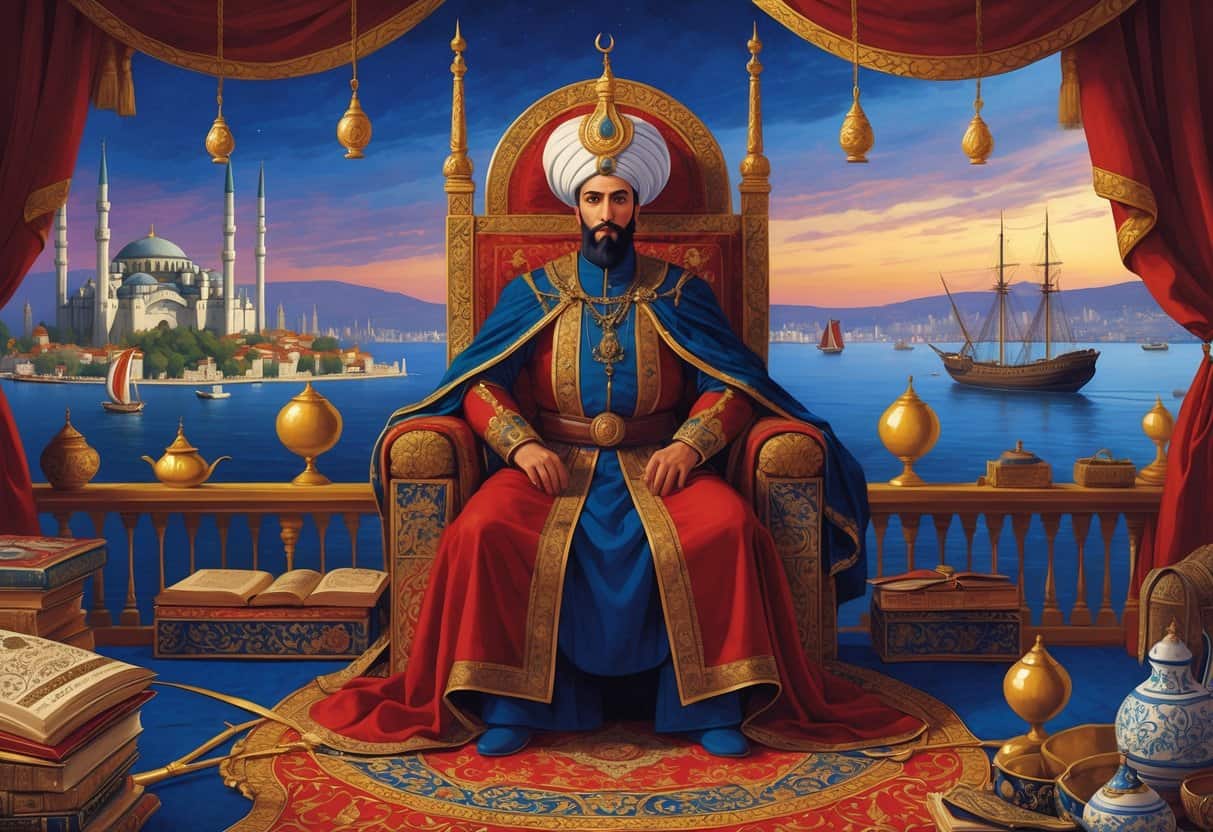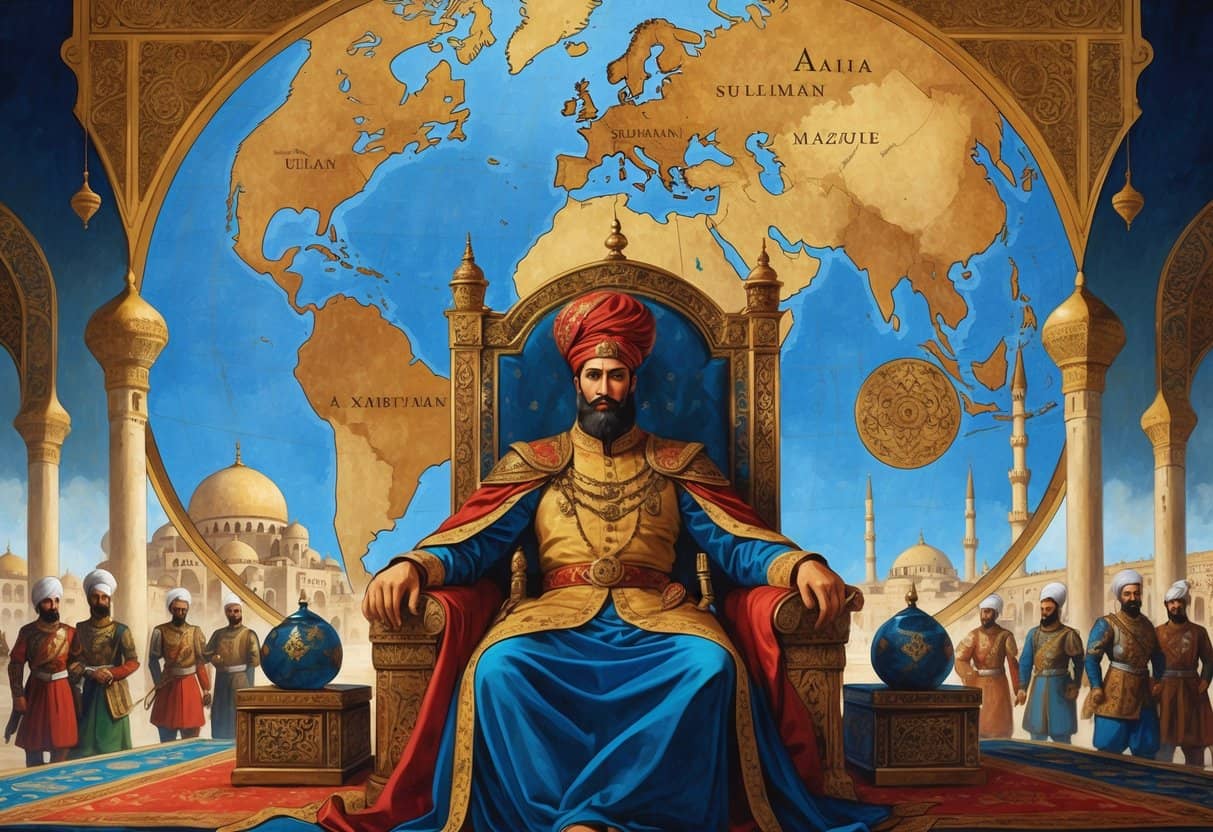The Ottoman Empire hit its peak under Suleiman the Magnificent.
You’ll see how Suleiman expanded the empire’s land, improved government, and promoted culture and law during his long rule.
His leadership shaped the empire into a powerful, organized state that influenced huge parts of the world.

Suleiman’s reign brought big changes in education, architecture, and the legal system.
These advances helped the empire grow and hold together through tough times.
Key Takeaways
- Suleiman expanded the empire’s territory and power.
- The Ottoman Empire thrived culturally and legally under his rule.
- Internal issues eventually affected the empire’s stability.
Rise and Political Power of the Ottoman Empire

The Ottoman Empire grew through careful military campaigns and control over key regions.
Strong government systems helped make it a dominant force in Europe, Asia, and Africa.
Expansion into Europe
Suleiman the Magnificent pushed the Ottoman Empire deep into Europe.
His forces captured Belgrade in 1521—a crucial step for controlling the Balkans.
The conquest of Hungary, especially the Battle of Mohács in 1526, was a turning point.
Ottoman forces crushed the Hungarian army, opening up central Europe for further expansion.
Suleiman even laid siege to Vienna in 1529, although the city held out.
These campaigns rattled European powers like the Habsburgs, and even France’s king, Francis I, tried to ally against the Ottomans.
The empire’s grip on Europe grew stronger as it secured cities and fortresses, locking down borders and trade routes.
Dominion Over North Africa and Asia
Suleiman stretched Ottoman control across North Africa and parts of Asia.
He captured the island of Rhodes from the Knights Hospitaller in 1522, which helped secure the eastern Mediterranean.
In North Africa, coastal cities fell under Ottoman rule, boosting control over trade and military routes.
In Asia, the Ottomans took regions like Iraq, bringing major Islamic centers into the empire.
This expanded Ottoman influence over much of the Muslim world.
Suleiman managed to balance military conquest with political control, always working to protect and grow the empire’s borders.
Centralization and Administration
Suleiman made the Ottoman government more effective by centralizing power and creating clear laws.
He ruled from Constantinople, which the Ottomans renamed Istanbul.
Suleiman wasn’t just a military leader—he was a lawgiver, too.
He introduced legal reforms called the Kanun, which organized civil and criminal law across the empire.
A strong bureaucracy managed the empire’s diverse peoples and vast lands.
Tax collection, justice, and military organization were all run from the center.
This system kept order and stability, letting Suleiman focus on expansion and good governance.
Cultural Flourishing in the Golden Age
The Ottoman Empire reached new heights in art, literature, and architecture during Suleiman’s reign.
This period was a burst of creativity that left a mark both within the empire and beyond.
The empire’s cultural achievements are still viewed as key examples of Islamic and world heritage.
Advances in Art and Literature
Under Suleiman, art and literature became more refined and widespread.
Poetry, calligraphy, and miniature painting really flourished.
Poets got strong support from the court, producing works that mixed classical themes with Ottoman culture.
Calligraphy was highly prized—used in religious texts, official documents, and decoration everywhere.
Miniature painting captured detailed scenes from history and daily life, visually recording Ottoman stories and ideas.
Literature also boomed, with writers exploring philosophy, politics, and love.
These works shaped Ottoman culture and influenced neighbors, too.
Architectural Achievements
Architecture during this golden age reached a peak, thanks largely to Mimar Sinan, the empire’s chief architect.
You can still visit many of his buildings—mosques, bridges, palaces.
His designs mixed function with beauty and symmetry, which is honestly impressive.
The Süleymaniye Mosque in Istanbul stands out as one of Sinan’s masterpieces.
It shows off classical Ottoman architecture with its huge domes and graceful minarets.
This mosque was more than a place of worship; it was a center for learning and community.
Sinan was a master at using space and light.
His buildings were both sturdy and artistic, showing off real engineering and aesthetic skill.
They became symbols of the empire’s strength and cultural sophistication.
Internal Problems and Decline
The Ottoman Empire ran into serious trouble during and after Suleiman’s reign.
Corruption crept into the government, rival powers like the Safavids pressed in, and long-term issues slowly weakened the empire.
Corruption and Administrative Challenges
Corruption in the administration became a growing problem, with officials putting personal gain ahead of duty.
Inefficiency and unfair practices spread.
Nepotism took hold—jobs went to family or friends instead of the best people.
The devşirme system, once a source of strong leadership, started to falter.
Military and civil services lost discipline and competence.
These internal struggles made it harder to govern such a huge empire.
Economic problems piled up as trade routes declined and mismanagement grew.
The government struggled to collect taxes fairly, and state income fell.
All these issues chipped away at the empire’s stability.
External Pressures and the Safavids
During Suleiman’s time and later, the Ottoman Empire faced steady threats from the Safavid Empire in Persia.
The two empires fought many battles along their long shared border.
Constant conflict drained resources and troops.
The Safavids pushed to expand, challenging Ottoman control in the east.
Meanwhile, European powers grew stronger and pressed the Ottomans on other fronts.
This extra pressure made it even tougher for the empire to defend itself.
These outside threats exposed the empire’s weaknesses and made reform or recovery a real challenge.
Long-Term Consequences
Corruption, internal decline, and outside pressure all mixed together, setting up what Europeans would later dub the “Sick Man of Europe.”
By the 19th and 20th centuries, the empire started bleeding territory at a startling pace.
You’d see the Ottomans losing their grip in the Balkans, while uprisings flared up within their own borders.
Reform efforts? Most came too late, or honestly, didn’t go far enough.
The decline rolled right into World War I. The empire threw in with the Central Powers and, well, that was pretty much the end after the war.